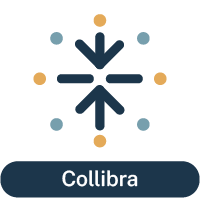In our experience, we know that people will support what they help create. In order to drive Collibra adoption in the best way possible, stakeholders must be involved with decision-making throughout the implementation – which means stakeholders need to be engaged before implementation starts. The true value of Collibra is actualized when it is used regularly by people in the business, so it is crucial to have both IT and business stakeholders represented during decision-making.
Finding the Initial Stakeholder Group
It’s also important to engage a diverse group of business and IT stakeholders to provide multiple perspectives. For example, IT stakeholders understand how Collibra works and what it can do from a technical perspective, and business stakeholders understand how the tool will be used and how it can benefit their teams for maximum impact.
Engaging these stakeholders not only facilitates collaboration, it can also ensure cross functional alignment and momentum around adoption. Ideally, you want your key stakeholders to feel engaged, invested and have a sense of ownership over the implementation and its success.
Engaging Stakeholders to Help Answer Questions
There are a lot of decisions that need to be made throughout your Collibra implementation, and the stakeholder group can help. Remember, this group is a key source of information and communication throughout the implementation cycle.
Some examples of stakeholder questions are:
- What type of information should go into Collibra?
- Who should have access and when should that access be granted?
- What, how and when should we communicate about Collibra?
- What resources should be allocated?
- When and how should resources be distributed?
In addition to creating a feedback loop, stakeholders can also help to identify value cases, user stories and compelling examples of how Collibra is impacting people on their teams and adding value across the organization.
Identifying Potential Stakeholders
The stakeholder group should be focused on the individuals who are closely tied to the initial Collibra implementation. This means these individuals will get to start using Collibra as soon as it is configured. It’s critical for this stakeholder group to be able to make decisions about resources and have authority over the initial user groups so decisions can be carried out efficiently.
Although the goal is to engage them early on in the implementation process, stakeholders can also remain consistent across the adoption process so they can enable continued momentum and ongoing engagement. Instead of disbanding this group, change the focus of their responsibilities. Ask them to share user stories with other groups and identify the ongoing benefits of Collibra for their teams. They can also provide insight into which teams or lines of business may benefit most from Collibra in future implementations and use case expansion.
Considering Change Champions and Ongoing Engagement
Another helpful group to consider assembling is a “Change Team” or “Change Champions.” Typically, a Change Team is comprised of 5-8 people on the front lines using the new technology. These individuals become the “go to” for colleagues with questions and concerns. Some key characteristics for identifying potential individuals for your Change Team includes having influence among Collibra users, ability to identify issues, and ability to provide feedback. This group can also help to provide a level of encouragement and support for change among their peers.
Change Champions can become your experts on the user experience and operational impact of Collibra, often providing feedback and recommendations far faster than any more formal data collection approach. Depending on how your Data Governance capability is structured, the Change Team could be an explicit part of your Data Governance organization, but doesn’t have to be.
Engage the right people at the right time is just the second of nine Collibra best practices we recommend on the adoption journey. Stay tuned for our next post on how to align technology adoption with change management to effectively avoid a waste of time, energy and resources.
View Becky Lyons’ Collibra Best Practices article series.
View Becky Lyons’ Collibra Best Practices article series.


